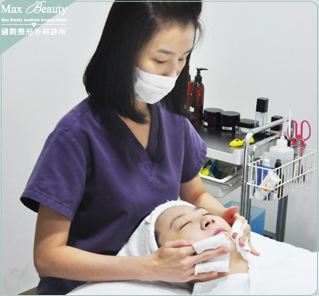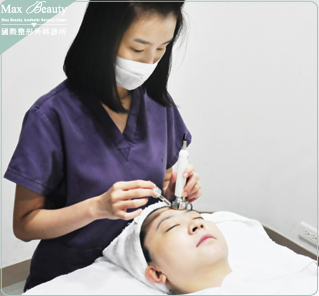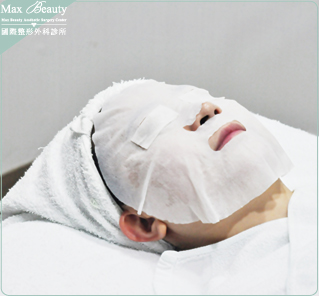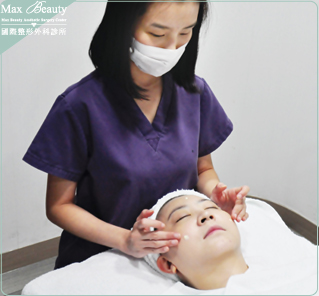Services

Resurfacing AHA
Resurfacing AHA
.jpg)
Application Features
Resurfacing AHA “AHA” has innumerable applications in cosmetic medicine, ranging from moisturizing, exfoliation, whitening, to skin problem improvement. The exfoliating effect of AHA, coupled with acai-alkaline actions will enable the skin to dissolve and peel off. Resurfacing AHA is a type of “chemical resurfacing”.
The so-called “chemical resurfacing” refers to “ applying one or multiple chemical peeling agents on the skin, causing the epidermis or dermis to be partially destroyed and generating new epidermis and dermis. Resurfacing AHA destroys only the “epidermis”, thus the name “surface resurfacing”. However, AHA is not suitable for everyone. People with sensitive skin may experience irritation, reddening, skin dryness, and scaling side effects during the early stage of AHA use. Please consult a medical professional or surgeon anytime a problem arises.
The surgeon will choose AHA of varied concentrations according to skin type and contraindication. It is applied in sequence, from the forehead, nose, checks, to the chin. Spray the neutralizer several minutes later. Apply cold press to alleviate pain and redness. Then, apply a moisturizer and sunblock. When undergoing resurfacing in the hospital, Resurfacing AHA must be progressively applied, from 20% (low concentration) to 70% (high concentration).
♦Efficacy.jpg)
According to experimental results in medical literatures, AHA as the resurfacing material can effectively eradicate acne, especially accompanying symptoms such as inflammatory pustules and papules. AHA can help the skin remove dead skin cells accumulated in the outer layer, stimulate the growth of new cells, accelerate skin renewal, reduce pores, and control excessive oil secretion. It can help the skin improve acne, dark spots, wrinkles, skin dryness and roughness, and other problems, making the skin supple, smooth, and elastic and achieving skin renewal results. It also promotes peeling of dead cells, prevent white heads/black heads formation, and speed up the disappearance of acne generated. Significant improvement is usually seen after AHA use.
♦Suitable Targets.jpg)
1.Young people with acne, white/black heads, pocks, and exuberant sebum secretion.
2.Those with dull skin and uneven brownish yellow skin, with a need to improve skin brightness.
3.Those with dull skin and cuticle hypertrophy.
4.Those who need to reduce pores and remove white heads/black heads.
5.Those who need to reduce oiliness and improve inflammatory pustules.
6.It promotes keratinocyte metabolism and refines the skin.
♦Therapy Time and Interval.jpg)
The therapy time differs with the scope of therapy. Each therapeutic session (preoperative and postoperative) is about 40-60 minutes. In general, the therapy is performed once every 2-4 weeks, about 8-10 sessions in total.
However, the surgeon’s recommendation will be based on the skin condition of individuals after an evaluation.
Treatment Process
Clinic consultation with surgeon (including photography)→cleansing→resurfacing AHA therapy conduction→importation of postoperative calming moisturization→repair and facial mask application→skincare and sunscreen.
 |
 |
|---|---|
| Cleansing | Resurfacing AHA therapy conduction |
 |
 |
 |
|---|---|---|
| Importation of postoperative calming moisturizing | Repair facial mask application | Skincare product and sunscreen application |
Precautions
| 1.If you feel normal after treatment, only slight tension or sensitivity, all you have to do is enhance moisturizing. |
| 2.Make a clinic revisit in case of obvious postoperative inflammation and redness. Apply topical ointment according to the doctor’s instructions. In case of scarring, let the scab fall off naturally. Do not scratch it to avoid scar formation. |
| 3.New skin after resurfacing is particularly sensitive to ultraviolet light; therefore, sunscreen is very important. Apply sunscreen every day and avoid staying outdoors under the sun. Be sure to wear a hat or use an umbrella when you are outdoors. |
| 4. Temporarily discontinue AHA, A acid, skincare products, or any pharmaceutical drugs that might irritate the skin before and after resurfacing. The said products can be used after the skin is restored to its “normal feel”. |
Q&A
Q:Is it true that the more frequently AHA is used, the thinner, more prone to allergies, and darker the skin gets?
A:Long-term AHA use will not cause skin thinning. According to foreign clinical reports, AHA can actually thicken the entire skin. In addition to an increased thickness of the dermis, the dead cells in the outer most layer of the epidermis will peel off. Through this dual effect, the skin will become firm, smooth, and elastic. Unless high-concentration AHA is inappropriately used in resurfacing, AHA care will not result in skin thinning.
Q:Can AHA be used during the day? If sunscreen is not used afterwards, will there be adverse effects?
A:AHA can be used during the day. After high-concentration AHA is used on the skin for resurfacing, baby soft skin can be restored. Sunscreen is recommended at this time Please take extra care of the skin since the skin at this stage is vulnerable to sunburns. Therefore, sunscreen protection is very important.
Q:Peeling occurs after AHA use. Is it an allergic reaction?
A:Glycolic acid used in traditional AHA cause slight tingling and itchiness for many patients. This feeling will disappear after about one minute due to the small molecular of glycolic acid and a lower pH. If irritation and redness persist, discontinue use. After the skin returns to normal, reduce the amount and frequency of use (e.g. once every 2-3 days). Resume daily use only when the skin’s tolerance has been established.
Q:Can I use vitamin C after AHA use?
A:AHA and vitamin C complementary each other as far as function is concerned. AHA produces significant improvement on stratum corneum metabolism. L-vitamin C has a good effect on collagen proliferation. It is recommended that both be used separately in the morning and evening (e.g. use vitamin C in the morning and AHA in the evening).